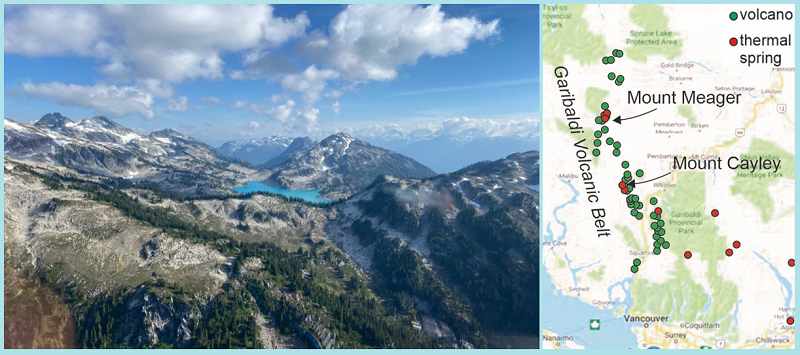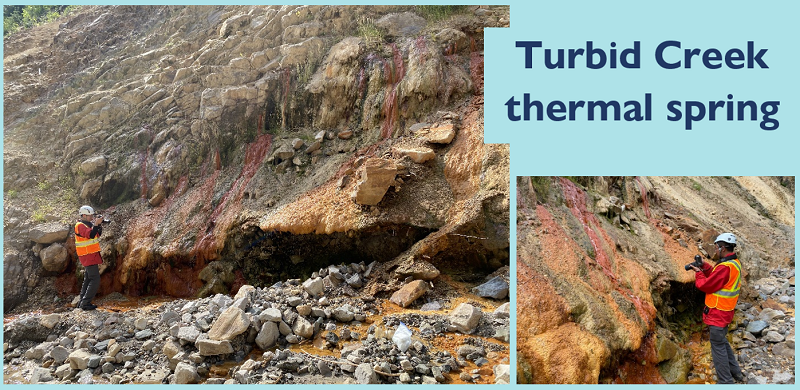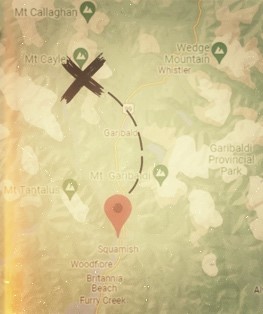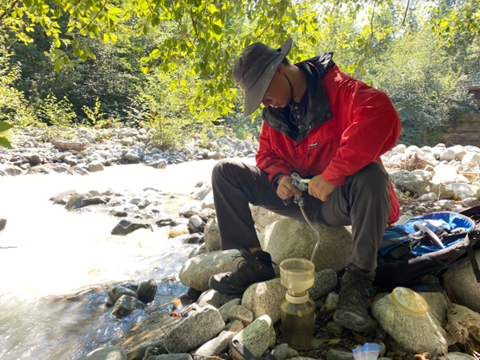This journey begins with a helicopter ride to a remote volcanic zone on the West Coast of British Columbia — a site noted for potential eruptions, steaming vents and unpredictable weather. It’s all in a day’s work for this scientific team. They’re searching for a hard-to-find, yet promising, piece of the puzzle in our work against climate change: geothermal energy.
December 2022
Deep inside volcanoes near Whistler, British Columbia, molten rock from the Earth’s crust is heating underground water reservoirs to temperatures beyond 250°C. Hidden mysteriously out of sight, beneath the surface, this superheated water could set the future of clean geothermal energy in Canada in motion and play a crucial role in Canada’s goal to reach net-zero emissions by 2050.

The Garibaldi Volcanic Belt, north of Vancouver, B.C.
On the Pacific Ring of Fire
In the summer of 2022, along Canada’s vast and rugged Garibaldi Volcanic Belt, a team of 20 researchers began their trek to locate those water sources and harness the power of volcanoes.
Canada’s West Coast is part of the Pacific Ring of Fire, a global zone of lands circling the Pacific Ocean, known as a hotbed of seismic activity, eruptions and earthquakes. This zone also happens to have access to the most impressive, highest-temperature natural sites of geothermal energy in the world: volcanoes.
For more than four decades, researchers have eyed this area’s potential, and now, with the rising global need for clean solutions, new interest in geothermal energy is shining a light on this region once again.

Researchers observe and collect data from cliff sides and mountain streams.
A quest to unearth a buried treasure: Geothermal energy
Geothermal energy harnesses heat from underground reservoirs of steam and hot water found in the Earth’s crust. It can be transformed into electricity to power our homes and businesses year-round. It also has the potential to heat and cool buildings and produce green hydrogen, which is a clean substitute for gas, diesel, coal and more. It is more environmentally friendly than conventional energy sources, with a smaller carbon footprint and lower emissions. And, unlike other clean energy solutions such as wind and solar, geothermal is available on demand.
The challenge is that geothermal energy is harder to locate compared to other clean energy solutions: it’s much easier to understand something tangible on the Earth’s surface, like the sun and wind, than it is to find heat sources deep underground. This research expedition set out to locate sources of geothermal energy, making it easier to tap into this promising natural resource.
“Developing new exploration tools to better locate geothermal reservoirs at depth will greatly reduce the economic risk of drilling wells,” says Dr. Steve Grasby, Research Scientist at Natural Resources Canada (NRCan). “This work is already attracting new industry interest in geothermal exploration.”
With support from Geoscience BC and NRCan’s Emerging Renewable Power Program, a wide-ranging team of geoscience experts from the Geological Survey of Canada (GSC) — along with partners from the University of Alberta, University of British Columbia, Simon Fraser University, University of Calgary and Carleton University — began their adventure into the Canadian Cordillera, B.C.’s vast network of mountain ranges.
X marks the spot for Canadian geothermal

Map showing Mount Cayley marked with an X, in relation to Whistler and Squamish.
Like many great tales of adventure and exploration, this quest started with an old map. In the 1970s, researchers from the GSC did extensive mapping of potential geothermal locations across Canada — prompted by concerns over energy security and driven by Canada’s geothermal research program. That’s also when Canada’s first geothermal well was drilled on Mount Meager, about 60 kilometres from Mount Cayley. Although the program was shut down in the 1980s when oil prices dropped, the work done by those researchers has made it possible for today's scientists to pick up where earlier researchers had left off.
“Previous research provides a critical foundation to build from and allows us to focus on the key areas of interest identified,” says Grasby. “Preservation of past data provides invaluable information to our research efforts and saves us from having to start all over from square one.”
The Garibaldi Volcanic Belt has been the site of several scientific studies, including deep seismic profiling, which identified a large “bright spot” about 10 kilometres below the surface of Mount Cayley, and a NRCan research well on Mount Meager that found waters up to 250°C only two kilometres below the surface.
With the world facing a different crisis today — that of a changing climate — it’s of great benefit that GSC scientists had a head start on their new quest to find geothermal energy.

Mount Cayley is found on the traditional, ancestral and unceded territory of the Coast Salish peoples.
Landing place of the Thunderbird
To the Squamish people, Mount Cayley is called t'aḵ'taḵmu'yin tl'a in7in'a'xe7en. In their language it means Landing Place of the Thunderbird. Just getting there is no easy feat. The top of the volcano features steep, jagged slopes and the base is surrounded by rough terrain. Even in the middle of summer, the high elevation means cold, wet snow and rain cover every surface — the team needed to come prepared for every off-grid possibility.
Each day, helicopters dropped teams of two to four people, carrying heavy backpacks and equipment, onto ridges, peaks and otherwise inaccessible valley bottoms. For some geophysical surveys, groups of four or more people had to carry the heavy, bulky survey equipment in addition to personal survival gear.
Mountain peaks in the Garibaldi Volcanic Belt.
While planning the expedition, Grasby and his team engaged with representatives of the Squamish Nation, as stewards of their traditional lands, to learn more about this geologically unique volcano. Through these discussions, the scientists took action to relocate proposed survey sites to eliminate any unintended intrusions onto sensitive areas. And Indigenous monitors joined the team to minimize environmental impacts as this area is home to wildlife, including mountain goats, coyotes, cougars, bobcats and bears. They also transferred knowledge of the work being done back to the community.
A new kind of worldly exploration: subsurface imaging
It was a tough journey, and one worth taking. The team completed measurements and surveys of the Earth’s natural magnetic and electrical fields. They also conducted gravity surveys of various locations on Mount Cayley. Much like a medical MRI scan, or magnetic resonance imaging, these tests provide an image of what is inside a volcano and help point to where zones of hot water might occur. Work was also done to characterize the natural fractures that control the flow of hot fluids, as well as to sample the thermal springs waters in the area.

Researcher collects data from a stream on Mount Cayley.
The search for Mount Cayley’s geothermal heart
Over the next year, researchers will use the data collected from this expedition and put together a comprehensive image of Mount Caley above and below ground. By identifying the “heart, veins and arteries” of the volcano, scientists will have enough information to locate potential magma chambers, fractures and high-permeability zones that carry geothermal fluids through the subsurface, linking deep magma chambers with thermal springs and vents, also known as fumaroles, found on the surface.
“The data are currently being processed and integrated into a new 3D model of the geothermal and volcanic plumbing system of Mount Cayley,” says Grasby. “This model should greatly reduce the risk associated with drilling for geothermal reservoirs in volcanic systems of British Columbia and help support Canada’s transition to a clean energy economy.”
While climate change is one of the greatest long-term threats that we face as a global community, geothermal development in Canada is a part of the solution. This research will help Canada transition from a hydrocarbon-based economy to a renewable, clean energy economy for a more sustainable future.
For more information:
More about Steve Grasby’s work on ResearchGate
About Renewable Energy (NRCan)
Helping Canada’s building sector go green (Simply Science article)